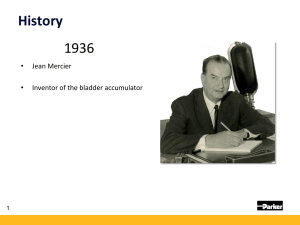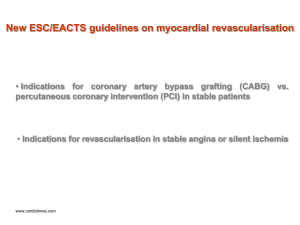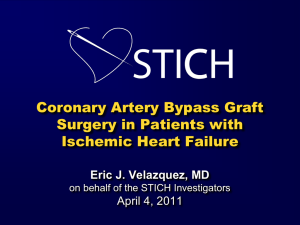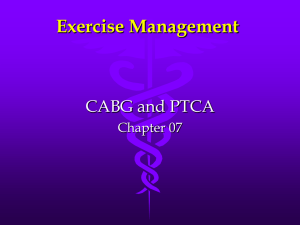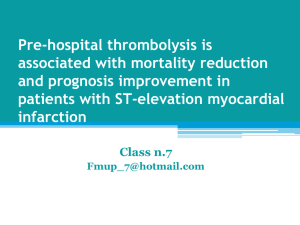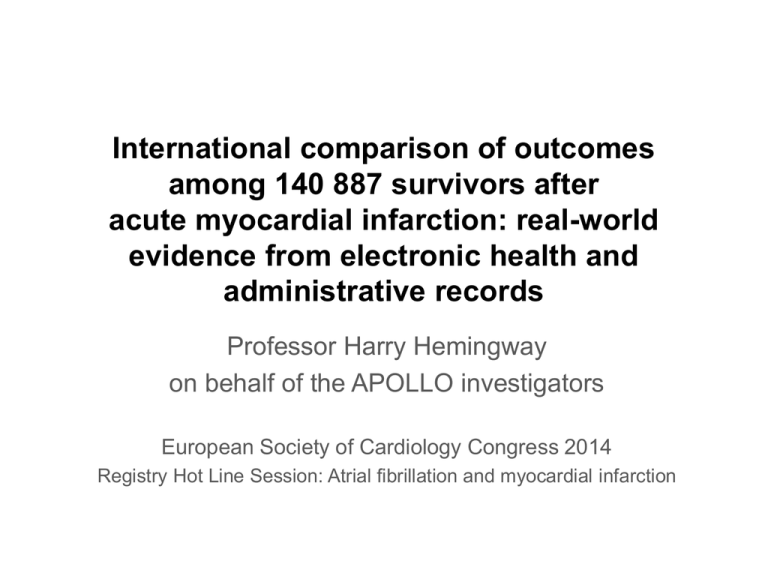
International comparison of outcomes
among 140 887 survivors after
acute myocardial infarction: real-world
evidence from electronic health and
administrative records
Professor Harry Hemingway
on behalf of the APOLLO investigators
European Society of Cardiology Congress 2014
Registry Hot Line Session: Atrial fibrillation and myocardial infarction
Authors
Eleni Rapsomaniki1, Magnus Janzon2, David J.
Cohen3, Tomas Jernberg4, Nicholas Moore5, Marcus
Thuresson6, Erru Yang7, Patrick Blin5, Saga
Johansson8, Harry Hemingway1
1Farr
Institute of Health Informatics Research, University College
London, UK
2Linkoping University, Sweden
3Saint Luke’s Mid America Heart Institute, Kansas City, USA
4Karolinska University Hospital, Sweden
5Department of Pharmacoepidemiology, University of Bordeaux, France
6Statisticon AB, Uppsala, Sweden
7Health Economics & Epidemiology, Evidera, Lexington, USA
8Observational Research Center, AstraZeneca R&D, Mölndal, Sweden
Conflicts
AstraZeneca funded the APOLLO Programme alongside
the PEGASUS-TIMI 54 study which is aimed at determining
the clinical efficacy and safety of long-term dual antiplatelet
therapy with ticagrelor plus aspirin for the prevention of
secondary cardiovascular events in patients with a recent
myocardial infarction and additional atherothrombotic risk
factors
Motivation
•
Importance
•
Uncertainty
•
Novel opportunity
– MI survivors
– International comparisons
– Unselected populations
– Long-term follow-up
– Non-fatal and fatal
– Benefits and harms
– Electronic health and administrative records
Objective
•
To compare atherothrombotic events, death and
bleeding risks in 1-year post-MI survivors across
Sweden, the USA, England and France over 3 years of
follow-up
Methods: electronic health records and
administrative data sources in APOLLO
Programme
Countries
Sweden
Record
sources
Details
USA
National
registries
•
•
•
Nationwide
Longitudinal
data
Hospital
discharge data
linked to
prescribed
data register
and death
registry
England
•
Age >65 years
Demographics
and health
insurance
claims
Linked to death
registry
EGB,
PMSI
CPRD,
MINAP, HES
Medicare
•
•
France
•
•
•
Four linked
datasets
Longitudinal
data
Primary and
secondary
care, and
disease
registry and
death registry
•
•
Sample of
national
healthcare
insurance data
Hospital
discharge data
linked to death
registry
CPRD, Clinical Practice Research Datalink; EGB, Echantillon Généraliste des Bénéficiaires; HES, Hospital Episodes Statistics;
MINAP, Myocardial Ischaemia National Audit Project; PMSI, Programme de médicalisation des systèmes d'information
Methods: study population, disease definitions
and statistics
•
•
•
•
Patients entered the study 1 year after the most recent
discharge for MI (study period: 2002–2011)
Disease definitions were harmonised using ICD9/ICD10
diagnostic codes
Data from each country were analysed using a common
protocol
Cox models were utilised to estimate adjusted risks and
relative risks, using Sweden as reference
ICD, International Classification of Diseases
Age- and sex-standardised prevalence of
comorbidities and secondary prevention treatments
Baseline comorbidities (%)
Treatments prescribed at 1 year post-MI (%)
63.9%
79.0%
Hypertension
76.1%
Statins
69.1%
68.7%
86.7%
80.4%
29.0%
40.7%
History of
heart failure
24.2%
29.6%
b-blockers
81.3%
68.5%
73.5%
ACEI/ARBs
71.4%
80.1%
71.3%
25.4%
38.5%
Diabetes
23.2%
28.0%
22.0%
24.2%
20.8%
16.9%
History of
atrial fibrillation
History of >1 MI
14.4%
11.7%
12.2%
13.5%
ADP-receptor
blockers
History of cancer
13.0%
7.9%
8.0%
15.2%
Dual
antiplatelet
49.7%
65.0%
22.9%
41.0%
28.6%
20
40
9.1%
Sweden, n=77 798
5.4%
10.5%
7.2%
61.6%
40
60
Percentage
80
14.1%
19.7%
CABG
France, n=1764
0.4%
20
38.7%
England, n=7238
4.2%
0
100
54.9%
48.1%
PCI
USA, n=53 909
11.2%
7.8%
7.8%
History of PAD
80
Revascularisation (%)
16.1%
7.5%
3.8%
History of
renal disease
60
Percentage
11.9%
11.2%
History of
hospitalised bleeding
54.4%
8.9%
8.4%
9.8%
0
10.8%
History of COPD
26.4%
Vitamin K
antagonists
11.3%
6.4%
8.3%
3.7%
History of stroke
82.3%
79.4%
80.0%
Aspirin
100
11.4%
7.1%
0
20
40
Percentage
60
80
ACEI, angiotensin-converting enzyme inhibitor; ADP, adenosine diphosphate; ARB, angiotensin receptor blocker; CABG,
coronary artery bypass graft; COPD, chronic obstructive pulmonary disease; MI, myocardial infarction; PAD, peripheral arterial
disease; PCI, percutaneous coronary intervention
Prognostic validity:
adjusted HRs of all-cause death
Number of
events
% in study
HR
CABG, no vs yes
Sweden
USA
England
France
Overall mean
15 233
22 498
659
222
12.6
16.9
10.4
5.6
1.67
2.21
2.00
1.75
1.92
(1.58–1.78)
(2.12–2.31)
(1.42–2.83)
(0.95–3.22)
(1.54–2.40)
Age per 10 years
Sweden
USA
England
France
Overall mean
15 233
22 498
659
222
2.15
1.79
1.69
1.79
1.85
(2.11–2.20)
(1.75–1.82)
(1.55–1.84)
(1.57–2.04)
(1.63–2.11)
PCI, no vs yes
Sweden
USA
England
France
Overall mean
15 233
22 498
659
222
55.8
42.9
41.8
65.0
1.90
1.71
1.87
1.85
1.81
(1.83–1.98)
(1.65–1.76)
(1.50–2.32)
(1.39–2.46)
(1.66–1.98)
History of renal disease
Sweden
USA
England
France
Overall mean
15 233
22 498
659
222
5.0
3.4
7.0
6.9
1.85
1.56
1.92
1.76
1.73
(1.72–1.92)
(1.50–1.62)
(1.57–2.34)
(1.22–2.54)
(1.53–1.96)
History of heart failure
Sweden
USA
England
France
Overall mean
15 233
22 498
659
222
27.7
45.0
21.0
23.2
1.68
1.72
1.56
1.45
1.70
(1.63–1.74)
(1.67–1.77)
(1.32–1.85)
(1.07–1.06)
(1.66–1.74)
0.5
1
2
3
4
5
95% CI
6
HR
CABG, coronary artery bypass graft; CI, confidence interval; HR, hazard ratio; PCI, percutaneous coronary intervention
3-year cumulative absolute risks
All-cause death
MI/stroke/all-cause death
Observed risk (%)
50
Observed risk (%)
50
Sweden 20.1 (19.7–20.4)
USA 30.2 (29.8–30.7)
England 13.7 (12.6–14.8)
France 14.3 (12.5–16.1)
40
30
40
30
20
20
10
10
0
0
0.0
0.5
1.0
1.5
2.0
Sweden 26.9 (26.5–27.2)
USA 36.2 (35.7–36.6)
England 24.1 (22.7–25.5)
France 17.9 (16.0–19.8)
2.5
3.0
0.0
0.5
Follow-up (years)
1.0
2.0
2.5
3.0
2.5
3.0
Follow-up (years)
Adjusted risk (%)
Adjusted risk (%)
20
30
Sweden 11.2 (10.9–11.5)
USA 12.8 (12.3–13.4)
England 8.7 (6.9–10.5)
France 12.4 (10.1–14.7)
15
1.5
Sweden 19.8 (19.4–20.2)
USA 18.2 (17.6–18.9)
England 21.3 (18.2–24.2)
France 16.7 (14.3–19.2)
25
20
15
10
10
5
5
0
0
0.0
0.5
1.0
1.5
2.0
2.5
3.0
Follow-up (years)
Shaded areas correspond to 95% confidence intervals
MI, myocardial infarction
0.0
0.5
1.0
1.5
2.0
Follow-up (years)
Relative risks vs Sweden
All-cause death
RR
95% CI
MI/stroke/
all-cause death
RR
95% CI
USA
Unadjusted (KM)
1.55
(1.50–1.61)
1.33
(1.29–1.37)
Age and sex
1.46
(1.39–1.53)
1.09
(1.05–1.13)
1.11
1.17
(1.05–1.18)
(1.11–1.24)
0.83
0.88
(0.80–0.87)
(0.84–0.92)
Unadjusted (KM)
0.77
(0.66–0.90)
0.89
(0.79–1.00)
Age and sex
1.04
(0.86–1.26)
1.12
(0.98–1.28)
1.04
0.90
(0.85–1.28)
(0.73–1.12)
1.12
1.04
(0.98–1.30)
(0.90–1.20)
Unadjusted (KM)
0.69
(0.56–0.84)
0.60
(0.50–0.72)
Age and sex
1.14
(0.93–1.41)
0.83
(0.70–0.99)
1.11
1.09
(0.88–1.39)
(0.86–1.37)
0.82
0.78
(0.68–0.98)
(0.64–0.94)
comorbiditiesa
+
+ PCI/CABG
England
comorbiditiesa
+
+ PCI/CABG
France
comorbiditiesa
+
+ PCI/CABG
0.75
1
RR
aComorbidities
1.5
0.75
1
1.5
RR
adjusted for history of >1 MI, hypertension, renal disease, heart failure, PAD, stroke, atrial fibrillation,
hospitalised bleeding, cancer and COPD. French group adjusted only for age, sex, and year of index MI. All models were
additionally adjusted for year of index MI
CABG, coronary artery bypass graft; CI, confidence interval; COPD, chronic obstructive pulmonary disease; KM, Kaplan–
Meier; MI, myocardial infarction; PAD, peripheral arterial disease; PCI, percutaneous coronary intervention; RR, relative risk
3-year cumulative risks of hospitalised
bleeding events
Observed risk (%)
6
Adjusted risk (%)
6
Sweden 2.5 (2.3–2.6)
USA 5.3 (5.1–5.5)
England 3.6 (2.9–4.3)
France 2.2 (1.4–3.0)
5
4
3
3
2
2
1
1
0
0
0.0
0.5
1.0
1.5
2.0
Sweden 2.0 (1.9–2.1)
USA 3.6 (3.2–4.0)
England 4.9 (2.7–7.0)
France 2.2 (1.5–3.4)
5
4
2.5
Follow-up (years)
3.0
RR (vs Sweden)
0.0
0.5
1.0
1.5
2.0
2.5
Follow-up (years)
3.0
RR
95% CI
USA
Unadjusted (KM)
Age and sex
+ comorbiditiesa
+ PCI/CABG
2.12
2.14
1.64
1.69
(1.92–2.34)
(1.92–2.38)
(1.45–1.84)
(1.51–1.90)
England
Unadjusted (KM)
Age and sex
+ comorbiditiesa
+ PCI/CABG
1.35
2.07
1.94
1.94
(0.91–2.01)
(1.40–3.07)
(1.28–2.93)
(1.28–2.93)
France
Unadjusted (KM)
Age and sex
+ comorbiditiesa
+ PCI/CABG
0.75
0.99
1.06
1.06
(0.42–1.33)
(0.58–1.69)
(0.62–1.81)
(0.62–1.81)
0.5
1
2
RR
Shaded areas correspond to 95% CIs
aComorbidities adjusted for history of >1 MI, hypertension, renal disease, heart failure, PAD, stroke, atrial fibrillation,
hospitalised bleeding, cancer and COPD. French group adjusted only for age, sex, and year of index MI. All models
additionally adjusted for year of index MI
CABG, coronary artery bypass graft; CI, confidence interval; COPD, chronic obstructive pulmonary disease; KM, Kaplan–
Meier; MI, myocardial infarction; PAD, peripheral arterial disease; PCI, percutaneous coronary intervention; RR, relative risk
Limitations
•
•
•
•
Medication information
– Lacking for USA
Data on cause-specific mortality
– Lacking for USA, France
Socioeconomic data
– Lacking for Sweden, USA, France
Patient age
– USA >65 years only
Main results summary
•
Among 140 887 1-year post-MI survivors drawn from
unselected electronic health and administrative records
populations:
– High-risk state (>3% annual all-cause death risk1,2)
– About half of deaths are non-cardiovascular
– Compared with European populations, US patients had
•
•
higher (age and sex-standardised) prevalence of comorbidities
higher adjusted all-cause mortality
– Risk of further MI, stroke or death remained high (about 1 in 5)
–
across the 3 years and across the 4 countries studied, with fairly
constant annual risks
Difference in risk of hospitalised bleeding in the USA and
England vs Sweden remained substantial
1Montalescot
2Fihn
G et al. Eur Heart J 2013;34:2949–3003
SD et al. J Am Coll Cardiol 2012;60:e44–e164
Clinical implications
•
•
•
•
•
Guidelines1,2
– Definition of ‘high risk’ needs to be considered
Policy
– Impetus to improve quality of healthcare systems
Primary care
– Need for a generalist approach
Evidence for regulators and clinicians
– New interventions and generalisability of trial results
National electronic health record resources
– Quality, scope and comparability
1Montalescot
2Fihn
G et al. Eur Heart J 2013;34:2949–3003
SD et al. J Am Coll Cardiol 2012;60:e44–e164
Acknowledgements
•
Editorial support was provided by Oxford
PharmaGenesis™ Ltd



